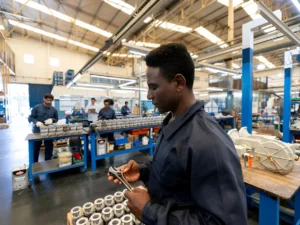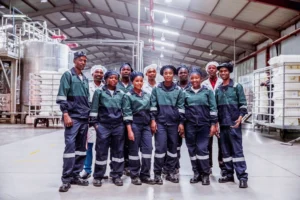“When the call came in, it was just after 6 a.m. and the business succession planning was about to be tested in real time.”
The CEO who is the founding visionary of one of West Africa’s largest integrated energy and infrastructure companies had collapsed in his home. A mild stroke. Stable, but serious enough to require months away from work.
The news spread like wildfire.
Employees were in shock. He had been the face of the business for over 18 years. The rainmaker. The strategic mind. The decision-maker. Nothing major moved without his signature.
Yet, what happened next surprised everyone.
The business… didn’t flinch.
There were no chaotic meetings. No boardroom panic. No suspended operations. No frantic calls to consultants. The leadership team met at 9 a.m. sharp. Calm. Prepared. Roles realigned. Stakeholder communications sent. Business as usual.
By close of business, project timelines were intact. Strategic partners had been engaged. Internal morale had stabilised. Not because the CEO was easily replaceable, far from it. But because, quietly over the past six years, the organisation had invested in serious, intentional leadership development, the kind of work that builds a resilient leadership pipeline and embeds proactive business succession planning.
They had built a bench.
And now, that bench held. This is what effective Leadership development looks like when it’s done with discipline and foresight.
This Is What Leadership Development Looks Like in the African Context
Six years prior, the board had expressed concerns. The CEO was still energetic and deeply involved, but he was also central to everything. Every strategy, every deal, every escalation. “What happens if he steps away?” someone had asked.
It was a confronting question. But instead of denying the risk, the leadership team responded the only way sustainable organisations do — they started building.
Then, they designed a multi-year programme to build these capabilities and to formalise a leadership pipeline aligned to clear business succession planning scenarios.
The first cohort of leaders — mostly mid-level project managers and functional heads — entered the programme a little uncertain. It wasn’t a training bootcamp. It was immersive, experiential, and deeply rooted in the reality of doing business in Africa. Modules covered everything from leading in volatile political environments to managing stakeholder complexity, and from cultural intelligence to ethical decision-making under pressure.
They didn’t just learn. They led.
Delegates were given stretch assignments across country operations. They ran internal change projects. They co-facilitated town halls. They presented quarterly reports to the board.
They were being tested — but more importantly, they were being trusted.
By year two, the culture was already shifting. Team leads were coaching. Managers were delegating with intent. Decision-making was more distributed. And people at every level began to understand: leadership isn’t a title — it’s a trust that must be grown through deliberate Leadership development in Africa programmes that feed the leadership pipeline.
Africa’s Challenge: The Founder’s Shadow and the Leadership Vacuum
Too many African organisations, family businesses, multinationals, conglomerates, suffer from a quiet but dangerous risk: founder dependency and poor business succession planning.
The founder or original MD remains the nucleus of the business; not by design, but by default. And as the business scales, the bench thins. When disruption comes ( illness, exit, acquisition) the organisation freezes. Because no one else knows how to lead.
It’s not because talent doesn’t exist. Africa is rich with talent. But talent without investment is potential without power. And that’s where many organisations fail. They wait for crisis to start building.
But not this organisation.
They invested before it became urgent. And when the moment came( when the CEO was out of commission) the business didn’t collapse. It leaned on its leadership pipeline.
The interim leadership structure held. Strategic decisions moved forward. Clients stayed confident. The board slept well. And by the time the CEO returned to office five months later, he found a stronger business than the one he left.
He wept during his first town hall back.
Not because of fear.
But because he saw finally that he had built something that would outlive him: a culture of Leadership development and disciplined business succession planning.
The Leadership Dividend: It’s Bigger Than Any Balance Sheet
We often talk about return on investment (ROI) in financial terms. But the real ROI of Leadership development is cultural, strategic, and generational.
It looks like:
- A high-potential female engineer in East Africa who rose to become the youngest regional director in company history; because someone sponsored her development early as part of a deliberate leadership pipeline.
- A once-quiet logistics lead in Lusophone Africa who now chairs the sustainability committee, because he was trained to think systemically.
- A 38-year-old operations manager who stepped in as acting CEO and held the role with quiet excellence because he’d already been prepared for the seat through robust business succession planning.
These are not theoretical case studies. These are real people in real companies, across Nigeria, Ghana, Kenya, Rwanda, Angola, and beyond.
And the common thread?
They were not left to figure it out on their own.
Their organisations bet on them early.
They were part of deliberate, structured Leadership development pathways.
They were seen, stretched, and supported.
Building the Bench: What High-Performing African Organisations Do Differently
We’ve worked with organisations across energy, telecoms, development finance, agriculture, tech, and logistics. The high performers all share one trait: they are never casual about leadership development.
They don’t see it as a training calendar item.
They see it as a core business strategy.
Here’s what they do differently:
- They define what leadership means in their context.
Not just generic competencies, but context-specific leadership models rooted in the realities of their industry, market, and culture and linked to a future-ready leadership pipeline. - They identify and grow leaders early.
They use tools like behavioural assessments, potential analysis, and 360-degree feedback to spot leadership potential not just performance and to populate the leadership pipeline with diversity and depth. - They invest in leadership journeys, not events.
Programmes span months or years. They include mentoring, coaching, peer learning, executive sponsorship, and applied projects which are the backbone of Leadership development in that compounds over time. - They tie leadership development to succession planning.
Every level has a visible leadership pipeline. Every executive can name their potential successor. - They celebrate those who build others.
Leader-managers are evaluated not just on delivery, but on how well they grow their teams and strengthen the leadership pipeline.
Africa’s Advantage Will Be Built on Leadership
As Africa’s population surges, its markets evolve, and its challenges grow more complex, one truth becomes clear:
Africa will not rise on policy alone. It will rise on leadership.
Leaders who can manage complexity, inspire trust, lead ethically, and build institutions that outlast them.
This is the leadership Africa needs.
And this is the leadership that must be grown — not assumed, not inherited, not rushed — through intentional Leadership development in Africa, anchored by resilient succession planning and a living leadership pipeline.
The good news?
It’s already happening. Quietly. Across industries. One leader at a time.
In the company where the CEO fell ill, that experience changed more than just the business. It changed the people inside it. It proved to them that leadership development isn’t a luxury, it’s infrastructure.
And just like good infrastructure, it carries the weight of tomorrow.
Final Thought: Who Are You Building?
If you are an executive, founder, or senior manager reading this, ask yourself:
- Who is ready to take your place if you step aside today, and is that readiness the product of structured succession planning?
- Who are you mentoring into your leadership pipeline?
- What structures are you leaving behind to sustain what you’ve built through Leadership development?
- Are you only driving performance, or are you developing successors?
Because leadership is not just about what you achieve.
It’s about who you empower to keep achieving after you’re gone.
If you lead a business in Africa, this is the moment to move from intention to infrastructure. Put names against roles. Fund the bench. Tie Leadership development directly to measurable outcomes and visible leadership pipeline depth. Do it now, so when disruption comes, your business succession planning isn’t theory. It’s muscle memory.





